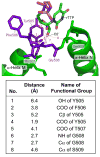A novel mechanism of sugar selection utilized by a human X-family DNA polymerase
- PMID: 19900463
- PMCID: PMC2814876
- DOI: 10.1016/j.jmb.2009.11.003
A novel mechanism of sugar selection utilized by a human X-family DNA polymerase
Abstract
During DNA synthesis, most DNA polymerases and reverse transcriptases select against ribonucleotides via a steric clash between the ribose 2'-hydroxyl group and the bulky side chain of an active-site residue. In this study, we demonstrated that human DNA polymerase lambda used a novel sugar selection mechanism to discriminate against ribonucleotides, whereby the ribose 2'-hydroxyl group was excluded mostly by a backbone segment and slightly by the side chain of Y505. Such steric clash was further demonstrated to be dependent on the size and orientation of the substituent covalently attached at the ribonucleotide C2'-position.
Copyright 2009 Elsevier Ltd. All rights reserved.
Figures






References
-
- Bonnin A, Lazaro JM, Blanco L, Salas M. A single tyrosine prevents insertion of ribonucleotides in the eukaryotic-type phi29 DNA polymerase. J Mol Biol. 1999;290:241–51. - PubMed
-
- Cases-Gonzalez CE, Gutierrez-Rivas M, Menendez-Arias L. Coupling ribose selection to fidelity of DNA synthesis. The role of Tyr-115 of human immunodeficiency virus type 1 reverse transcriptase. J Biol Chem. 2000;275:19759–67. - PubMed
-
- Yang G, Franklin M, Li J, Lin TC, Konigsberg W. A conserved Tyr residue is required for sugar selectivity in a Pol alpha DNA polymerase. Biochemistry. 2002;41:10256–61. - PubMed
Publication types
MeSH terms
Substances
Grants and funding
LinkOut - more resources
Full Text Sources
Other Literature Sources
Miscellaneous

